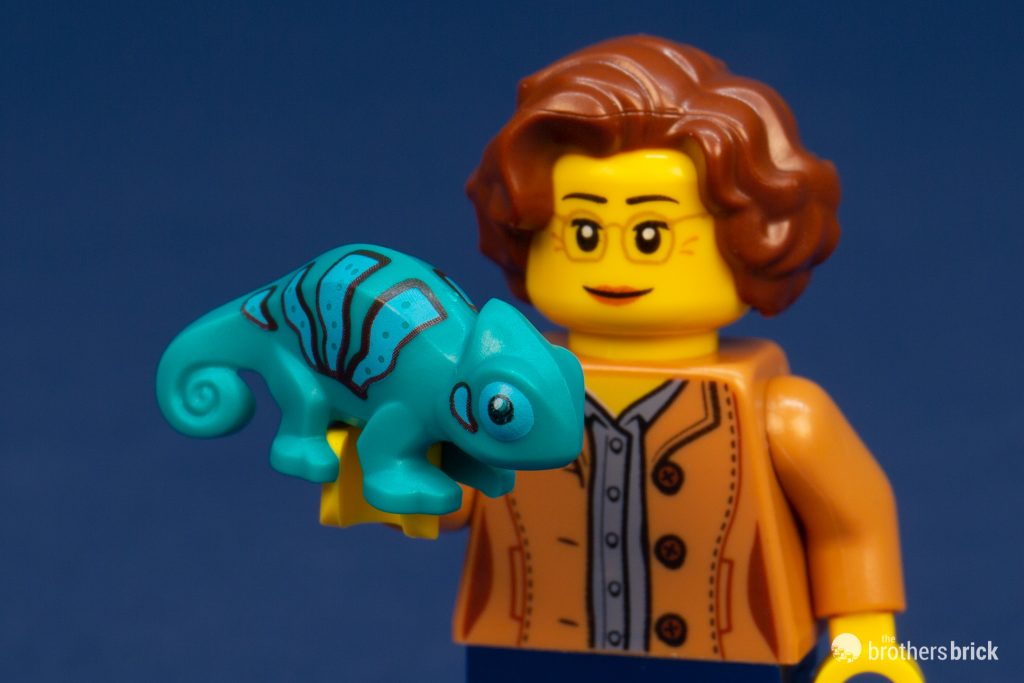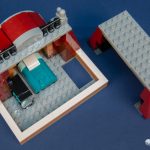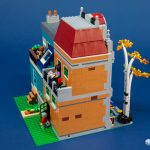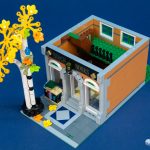Over the years, LEGO’s Creator Expert line of modular buildings has alternated back and forth between European-style buildings like the original Cafe Corner and American architecture like 10197 Fire Brigade 10 years ago and the more recent 10260 Downtown Diner and 10264 Corner Garage. The era and location that inspired 10270 Bookshop are less obvious, because this pair of side-by-side buildings could fit right in on streets as far-flung as Boston and Amsterdam.
10270 Bookshop includes 2,504 pieces with five minifigs and will be available on January 1st (US $179.99 | CAN $199.99 | UK £149.99).
The box, packaging, and printed parts
Modular boxes are huge, and at 2,500 pieces, this box is no different. The front features the two buildings alone against an autumnal backdrop, while the back features interior scenes and the new buildings together with the two immediately previous modulars.
The parts come in 8 sets of numbered bags (for a total of 18), plus an unnumbered bag for large plates, along with the two loose green baseplates. The instruction booklet ships in its own sleeve, and there is no sticker sheet.
A variety of printed parts add details throughout the build, including two 2×4 tiles for the bookshop’s sign and corner tile for the house number of the apartment next door. The “Once upon a time…” tiles are not new, nor is the clock (both appeared in 71040 Cinderella Castle). The only printed book cover is Moby Brick, with a wonderful white brick breaching the waves.
The build & techniques
After more than a decade, to say that Creator Expert modulars include innovative building techniques feels at this point like a bit of a cliché — we’ve simply come to expect no less from the design team at LEGO. The first bags provide the parts for the bookshop itself, creating a tiled floor and a pavement out front with a built-in design.
The combination of 2×2 corner tiles, 2×2 curved tiles, and 1×1 curved tiles all provide a much larger palette for mosaic designs.
The birch tree that gives the book store its name is enclosed in an iron grating, built on its side with black sausages for the ironwork.
By the end of the first two sets of bags, the first floor of the bookshop is complete, with a few parts from the third bag to complete the mezzanine level.
The third bag group completes the second floor of the bookstore, with a gorgeous circular staircase with green velvet steps.
With the fourth group of bags, the bookshop gets a tiny bedroom, but the highlight of the top floor is the front facade, which puts a variety of curved tiles to great use, evoking the facades of rowhouses in the Netherlands.
The fifth group of bags begins with the base for the apartment next to the bookshop, with a footprint that extends out onto the sidewalk.
Although not tall enough for a minifig to actually walk upright, the first level contains a basement.
The angled stairs leading up to the front door of the apartment are built using a combination of a Nexo Knights shield tile and triangle tile, providing an ingenious way to change the direction of the steps.
Where the bookshop has a fairly square footprint, a bay window extends out from the teal house. The windows are built on a hinged base, with a frame made from candle pieces.
The rounded window frames extend to the attic floor, with a scalloped tile design for the roof. The triangular front of the gables are attached simply, with Technic half-pins.
The finished buildings
Taking a step back when I finished the build, my first impression was just how much smaller the buildings are, both in height and depth. Downtown Diner has a similar part count and price, but both the art deco radio station and the apartment extend a full three stories, while the teal house only has one story with an attic.
Some of the part count comes from the fact that these are two completely stand-alone buildings side by side. This means there is an extra interior wall, with no doorways and other gaps between the halves, plus extra furnishings to decorate the additional walls.
The backs of both buildings are very plain, with balconies that shrink the footprint of the upper floors in relation to the ground floors.
A small vegetable patch with a new-style pumpkin does provide some interest behind the teal house, and stairs get you to the first floor above the abbreviated basement level.
With few exceptions (such as the original Cafe Corner with bare upper floors), modular buildings have detailed interiors on every floor. The bookshop itself features a cash register and bookshelves on the first floor, plus a mezzanine with another small bookshelf. The middle floor has a comfy chair, circular rug, and grandfather clock — all squeezed into the space left by the spiral staircase. Finally, the top level in the attic has a bed with a terrarium for the owner’s chameleon.
The teal building also has a sitting room on the main floor that is decorated with a small table, fireplace, and cabinet. Another attic bedroom features one of the best LEGO beds I’ve ever seen in an official set.
The minifigs & accessories
The last several modular buildings have included minifigs with “modern” faces rather than the classic smiley. I feel that this adds character to the minifigs, but I know others disagree. For those who prefer the classic smiley, I expect you already have hundreds in your collection, so a quick swap is an easy solution.
The Moby Brick book is certainly the star accessory in the set, and harkens to the many clever movie title parodies in sets like 10232 Palace Cinema.
Another fantastic accessory is the chameleon, which appeared in a different design with the revamped Johnny Thunder in Collectible Minifigures Series 19 earlier this year.
Finally, the little boy has a brick-built model airplane that uses a beanie propellor to achieve the perfect scale, although I’m less convinced by the rocket base (with four fins) for the tail.
Conclusions & recommendation
My favorite modular building is 10246 Detective’s Office from 2015. Like 10270 Bookshop, it features two buildings, but they’re integrated with each other rather than being on separate baseplates. Many LEGO fans have asked for another side-by-side pair of separate buildings like 10190 Market Street (2007). However, I’m not convinced that the extra modularity is worth the tradeoff in parts from the interior walls, resulting in a much smaller build than most other recent modulars.
Should modular fans (myself included) add this to their collection? Of course. It has a great exterior, really fun interior details, and provides an opportunity to learn fascinating new building techniques. And the extra parts include a substantial quantity of teal bricks, which Mark Stafford killed initially more than a decade ago.
Nevertheless, my recommendation is qualified by the lower profile, which makes this latest modular feel less substantial than fantastic modulars like Detective’s Office and Corner Garage.
10270 Bookshop includes 2,504 pieces and 5 minifigs and will be available January 1st from the LEGO Shop (US $179.99 | CAN $199.99 | UK £149.99) and elsewhere.
The LEGO Group sent The Brothers Brick an early copy of this set for review. Providing TBB with products for review guarantees neither coverage nor positive reviews.






















































































I always enjoy your thorough reviews. Insta-click!
Fantastic review – thank you!!
Excellent review as allways
The real building is way too small. I’m not convinced the brick count in an interior wall should have meant an entire floor missing. Both buildings in the pet shop have 3 floors and it cost less. LEGO has made some bad decisions with each modular starting with the diner
Excellent review! You have a good point by comparing it to detective office and as such, I am wondering if it would not make more sense to sell these houses separately? Because I do really like these models and will buy them.
Great review! As always ;)
This ia a great replacement for the aging Petshop, yes is a classic set, but it showing its age. The the new townhouse actually sits taller then the Detective Office, when compared.
Great review. I will be getting it despite it’s smaller height compared to others. I am ok with that as it will add variety.
When people start to compare the modular buildings, it appears that people are drawn to styles of certain designers. I have compiled a list of the modular buildings and the lead designers associated with them below. Because Jamie Berard has designed 8 of the 15 modular building sets, it’s natural to compare all of them to his styling to which many have take liking to.
Modular Building Name (Set Lead Designer) Year Released
– – – – – – – – – – – – – – – – – – – – – – – – – – – – – – – –
Market Street (Eric Brok (AFOL)) 2007
Cafe Corner (Jamie Berard) 2007
Green Grocer (Jamie Berard) 2008
Fire Brigade (Jamie Berard) 2009
Grand Emporium (Jamie Berard) 2010
Pet Shop (Jamie Berard) 2011
Town Hall (Astrid Graabæk) 2012
Palace Cinema (Astrid Graabæk) 2013
Parisian Restaurant (Jamie Berard) 2014
Detective’s Office (Jamie Berard) 2015
Brick Bank (Nick Vas) 2016
Assembly Square (Jamie Berard) 2017
Downtown Diner (Mike Psiaki) 2018
Corner Garage (Lars Joe) 2019
Bookshop (Wes Talbott) 2020
Showing its age? What a nut. It’s not a laptop or fashion accessory from gucci.